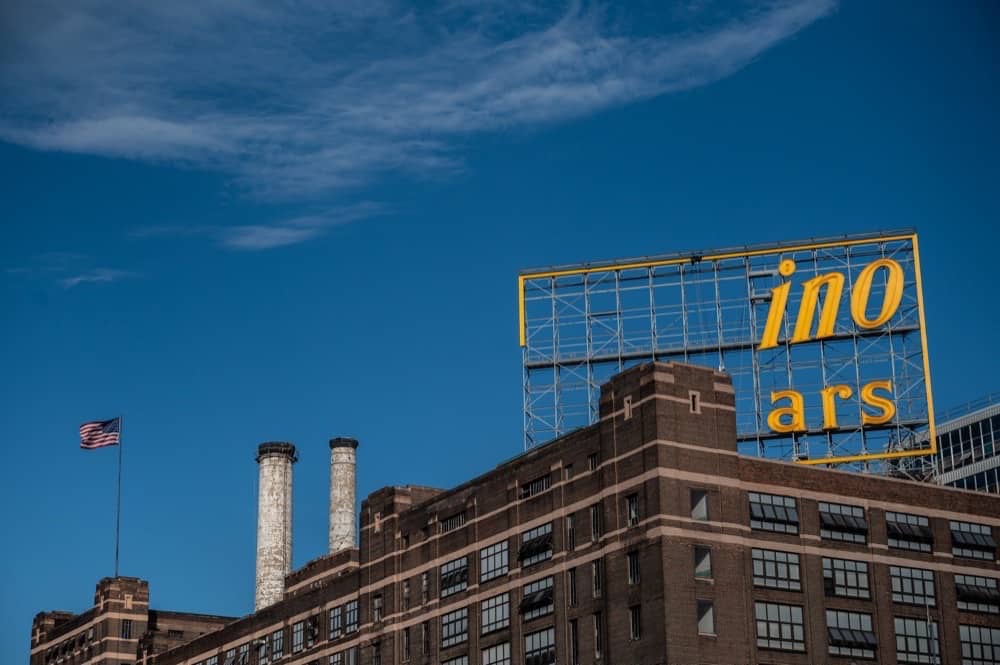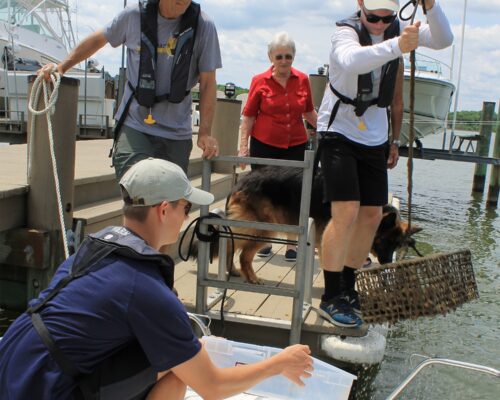The rebirth of the Domino Sugar Sign
Susan Walker Millard had a bushel basket of hometown desire for Baltimore’s sweet spot.
“Every time we sailed past [the Domino Sugar] sign, I’d tell my friends, ‘You know that dot over the ‘i’ in Domino is six feet tall? I’d love to have it.’”
Not only did Millard not get the desired dot—“I really, really wanted it,” said the enthusiast of all things Baltimore—but Susie’s facts were a bit off.
“They gave it to the Museum of Industry,” said Millard, a Baltimore County resident who once chaperoned her son’s field trip to the massive sugar refinery. “It’s five feet, not six.”
Actually…
“It’s five feet tall, two-and-a-half inches, and it weighs about 190 pounds,” said Claire Mullins, the Baltimore Museum of Industry marketing director. “We’re going to put it near our wall of windows that look out on the harbor and the sugar factory. We cherish it.”
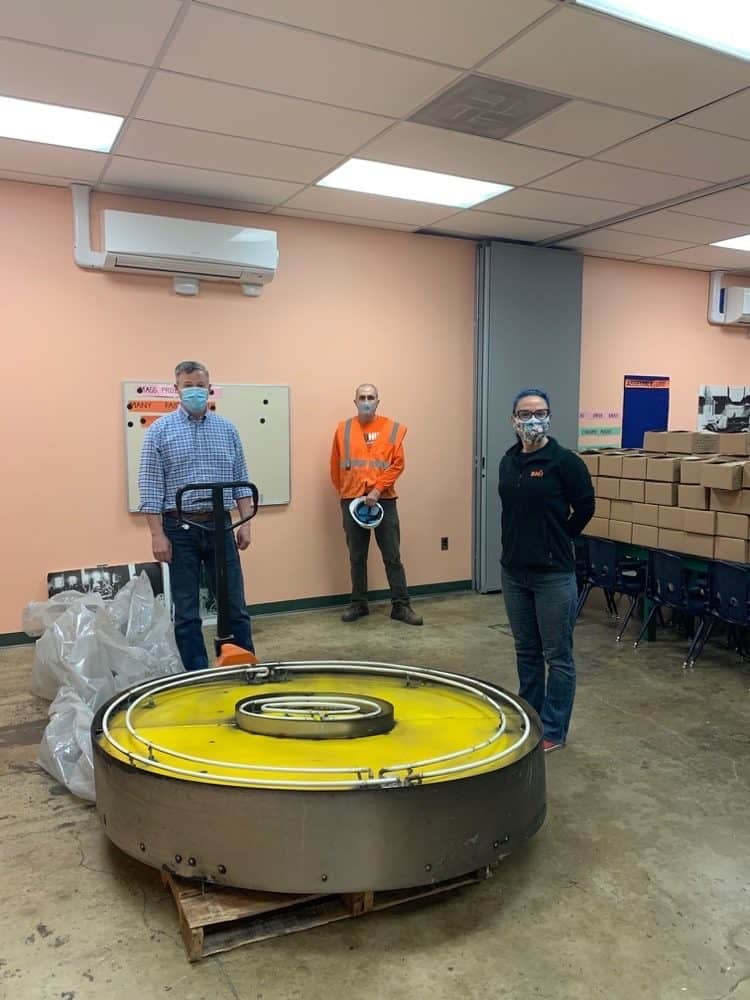
Generations of Baltimoreans—longshoremen, housewives hanging wash, tugboat crews, South Baltimore residents both working-class and gentrified, and folks across the harbor in Fells Point—have long cherished the fabled neon sign.
Rising 16 stories above the harbor on the roof of the nearly century-old refinery, the 120-foot by 70-foot sign flashed to life on April 25, 1951 when engineers turned the switch for the first time.
Bees and wasps were especially fond of the sticky sugar residue that clung to the neon tubing, nectar turned black with soot. Birds long made nests in the letters, finding privacy in the holes rusted through the structure from which they hung.
Since the Truman Administration, the apricot glow (or is it blood orange?) of 12 gigantic letters—don’t forget to dot the “i”—has comforted locals and entertained folks just passing through.
They spelled “Domino Sugars” but said—loudly—Bawlmer.
“I’ve played music at the Cat’s Eye Pub lots of times,” said old school R&B guitarist David Goodfriend, a Garden State native long in love with Crabtown. “On breaks I’d walk down to the [west] end of Thames Street just to look at the sign. I always wanted to write a song about it.”
And he did, with lyrics that pay homage to a hard town by the sea: “Sweet sign, Domino, harbor light, Patapsco …”
Why all the hubbub about a beacon that has glowed in the city’s psyche for as long as anyone can remember?
Because it’s been dark since March as the structure’s 650 neon tubes are being swapped out for LED lights, a perceived loss that metro residents across all demographics have been mourning as though their great-grandmother’s engagement ring fell into the murky, upriver waters of the Patapsco.
A three-alarm fire in late April at the plant’s raw sugar storage shed—which, wrote Baltimore Sun reporter Colin Campbell, perfumed the waterfront “with the heavy aromas of crème brûlée”—did not cause such concern.
“I don’t like the idea, some things shouldn’t change,” said Goodfriend. “Neon just looks better to my eye, it’s richer and brighter. I can tell the difference.”
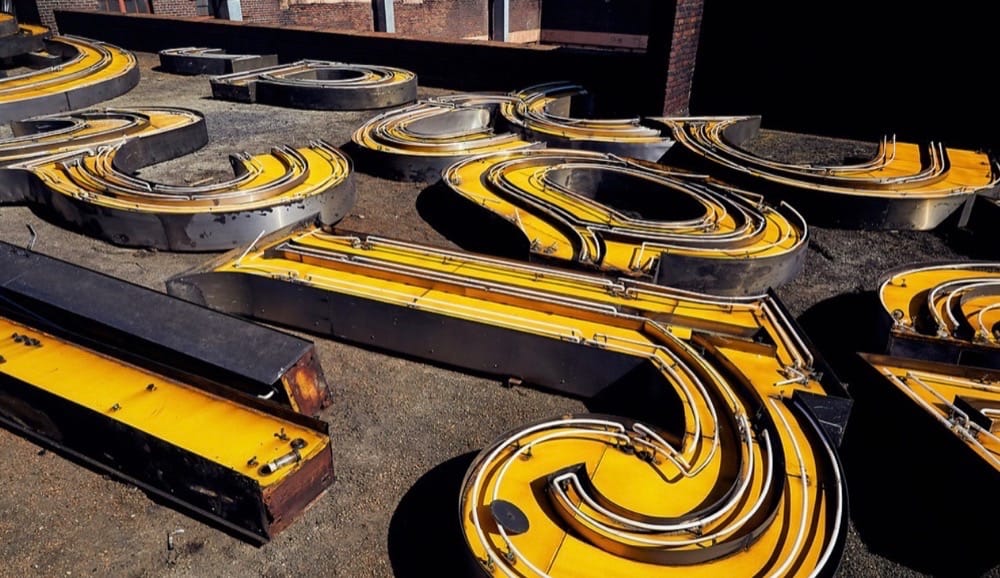
Perhaps.
This July, from a score of angles in and around the Inner Harbor, doubters will see how closely the future has replaced the past. Ceremonial lighting of the new sign is scheduled for the Fourth of July. Because there will be no harbor fireworks this year, the updated Domino logo will have the harbor stage to itself.
It was from the deck of Phyllis Hamblin Novotny’s family sailboat Serenity that Susan Millard—without fail—expressed her love for “the dot” on nocturnal excursions. Millard’s fantasy was to have it affixed to Serenity in honor of a lifetime friendship with Phyllis, with whom she bonded when they worked as bartenders together long ago.
Like Goodfriend, Novotny fears the new sign will “look different,” not unlike that close-but-not-quite taste of a relative’s casserole who swears they finally cracked Great Aunt Evelyn’s secret. The little difference is all the difference.
On Independence Day, Novotny and her husband John plan to sail from their berth at the Anchorage Marina in Canton to South Baltimore to see for themselves.
Neon is not necessarily richer than LED lighting; it is nostalgia that persuades us to believe it is. When a number of neon tubes blew out over a year ago, as they habitually did, refinery officials made a $2 million decision to switch over.
“We’ve put in a huge amount of time and effort to make sure it’s historically correct—that it will look exactly like the old sign,” said Rich Baker, vice-president of corporate engineering for American Sugar Refining, Inc. of Florida.
The ASR Group is the largest refiner of sugar in the world and owns the Domino Sugar Baltimore Refinery, a 30-acre plant bounded by the harbor and Key Highway and known locally as “the sugar house.”
Some 6.5 million pounds of raw cane sugar is processed there daily. And while the product is globally synonymous with sugar—and often confused with the company that produces it—Domino is merely a brand.
The decision to replace neon with LED was driven by many factors. Two companies in the metro area that “bend neon” tubing were located but future repairs and energy costs were daunting.
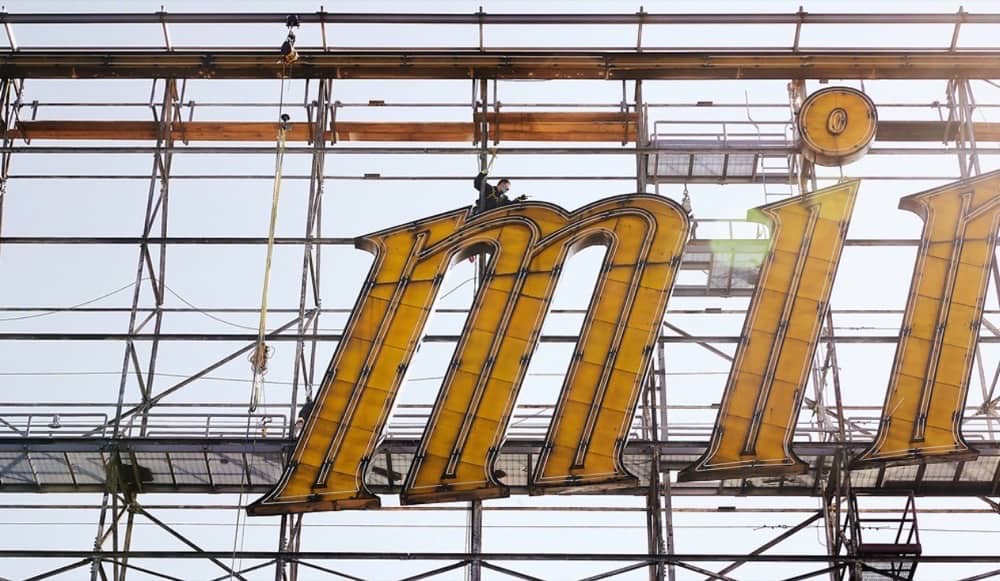
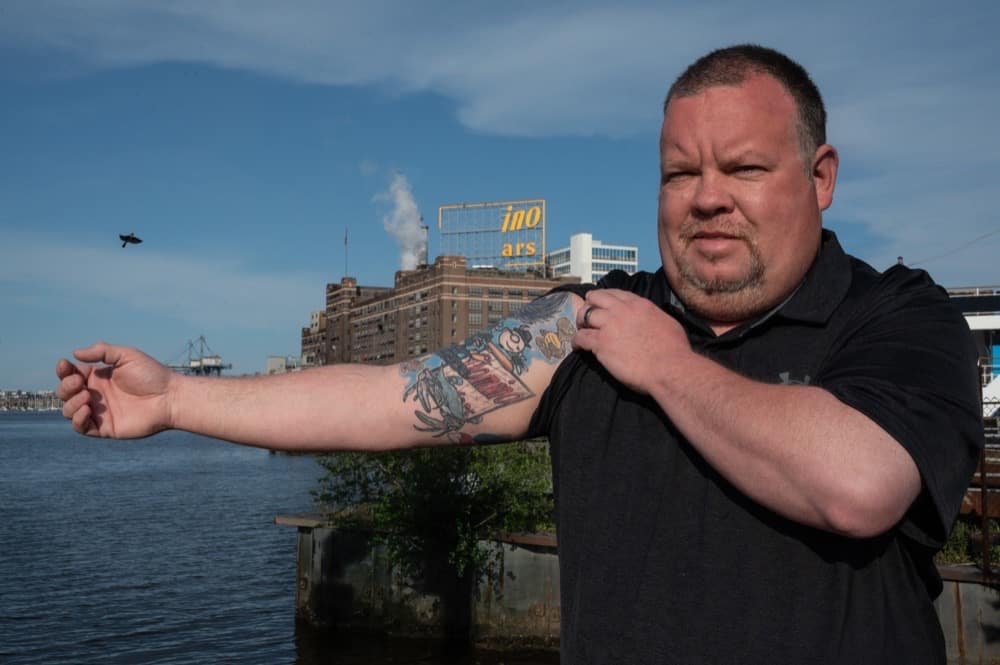
Like vinyl LP records, neon isn’t dead but has become something of a novelty, more likely to be found in suburban man caves than outside of a saloon. The craft is now taught more in art schools than apprentice shops as commercial practitioners age out of the game.
“This is happening throughout the lighting industry everywhere,” said Robert M. Kaye, a longtime employee of the Triangle Sign Company in Halethorpe and now a consultant there. Triangle installed the original Domino sign once it had been fabricated by the Artkraft Strauss company of Manhattan.
Mike Kestle’s Baltimore pedigree is forged in the working-class sweat long symbolized by the Domino Sugar sign. The refinery is just about the lone industrial survivor along a waterfront where everything from laundry detergent to deep sea freighters and cinnamon left Baltimore for the world.
It was the incandescent soul of a city built not on pleasure, as the modern waterfront’s marinas might suggest, but the kind of labor performed by more than 500 employees at the Key Highway plant.
Kestle’s maternal great-grandparents—Fred and Frances McCoy—sold eggs and butter from a stall at Hollins Market in southwest Baltimore. Frances did side work as a chocolate dipper for Glauber’s Fine Candies, and his maternal grandfather, the late Joseph Leroy Montley, loaded trucks and rail cars at the Philadelphia Quartz company on Fort Avenue.
Kestle, 46, is a grocery man for Weis Markets and a supervisor of ushers at Oriole Park at Camden Yards. He honors his grandfather and the city he loves with a tattoo on his right arm.
He is one of many locals of a certain age and attitude with similar tattoos, everything from Black-eyed Susans to the Bromo Seltzer tower.
“I got the Domino tattoo about 10 years ago; it was my fourth one after the Ravens and the Orioles and Natty Boh,” said Kestle. “When I was a kid we’d always go down to my grandfather’s job for crab feasts and the Domino sign was always there. I associate it with my grandfather, who I consider my father. Once you saw the sign, you knew you were home.”
One of the last prominent neon signs produced by Triangle was the winking, 38-foot wide “Mr. Boh” sign above the former National Brewery in Canton. Since then, said Kaye, LED technology has improved, and with it, energy efficiency.
“Neon tubing requires skilled craftspeople; LED does not,” said Kaye, comparing the demise to the fate of hot lead in printing. “Neon is dying.”
In its wake, the Gable company of Curtis Bay—which illuminated the old Montgomery Ward building on the edge of Carroll Park when it was reconstituted as Montgomery Park—was hired to build a 21st-century replica that will reduce energy costs and CO2 emissions.
“The new sign is aluminum rather than steel and will be more sustainable,” said Peter C. O’Malley, vice president of corporate relations with ASR. “It will last at least another 70 years.”
Gable’s challenge in duplicating the sign “to the letter” included getting the right shade of yellow paint to back the letters and measuring the amount of space between the tubes. Each letter was scanned and studied to the minutest detail.
It was “very laborious,” said O’Malley, “to take out a broken tube and replicate its shape. Many of the replacement tubes didn’t really follow the lighting pattern intended by the original design.”
Baker said that people who gazed at test panels for the new sign could not tell the difference.
A quarter of a century ago, in one of countless stories written about the sign over the decades, a reporter asked Mickey Seither—then chief engineer of the Baltimore plant—what might become of it in the future.
Seither replied: “We have no intention of doing anything with this sign except keeping it lit.”
et’s return, one last time, to the doubters; those who are certain that when the new sign debuts they’ll be able to navigate the tricks that memory plays.
“The average person won’t be able to tell the difference because [orangish-red] is easy for LED to duplicate,” said Kaye, noting that many neon signs of the past, including the 2 O’Clock Club and its kin on the Block, had no distinctive color at all, just white.
“There are shades of blue and ruby red that you can only get by putting neon gas in a glass tube, but the Domino sign will look the same.”
So, sugar babies, what does become of the broken hearted?
The large 34-foot tall “D” will be cut into small chunks and given to employees. The lowercase “a” in sugars was given to Anderson Industrial Contracting near Carroll Park. Anderson disassembled the old sign and is helping the Museum of Industry install “the dot.”
Remaining letters—M is for Mayor Schaefer, O is for Orioles, R is for Ravens, and S is for Sparrows Point—have been given to the Second Chance reclamation warehouse near Ravens Stadium on Russell Street.
S, of course, is for Susie and lest Millard cry herself to sleep, there is a final act of generosity from the ASR group.
The Domino “D” is being split into souvenir pieces, with some of it going to employees, and the rest on sale later this year in the Baltimore Museum of Industry gift shop. A great stocking stuffer for Millard and Frank G. Lidinsky, who has his own story of what the sign means to him, a long-ago memory tinted not sepia but orange.
“When I was a kid, maybe nine or 10 years old, my parents would take us and my grandmother to Betterton Beach [Kent County] on one of the Old Bay Line ships,” said Lidinsky. “I always knew when I was back in Baltimore when I saw the Domino sign.”

